2008 VOLKSWAGEN GOLF jump start
[x] Cancel search: jump startPage 15 of 444
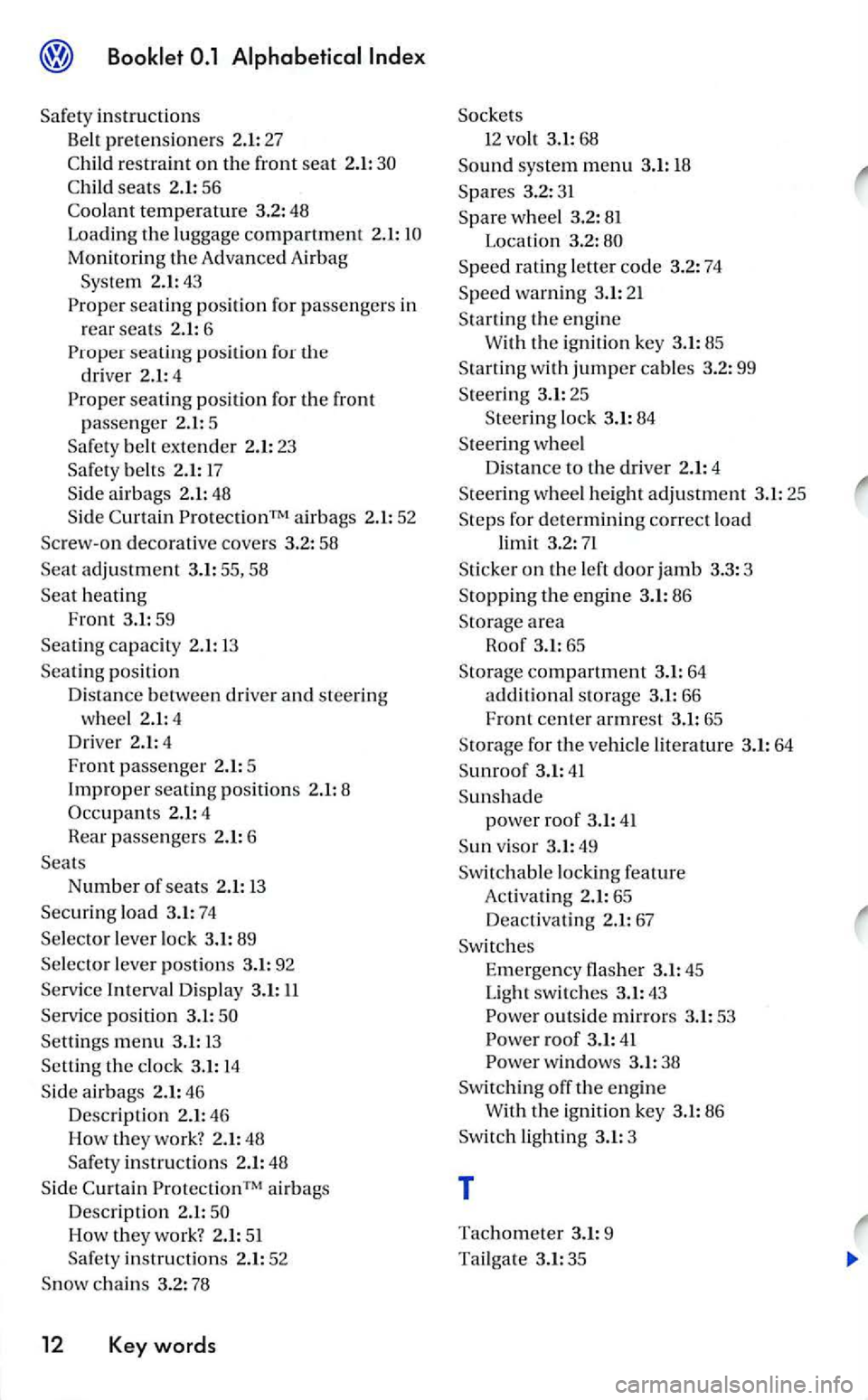
Safety instructions
Belt pretensioners 2.1: 27
Child restraint on the front seat 2.1:
Child seats 2.1 : 56
Coolant tempera ture 3.2:48
Loading
the lu ggage compartment 2.1:
seating position for passengers in
r
ear seat s 2.1: 6 seating position for
driver 2.1: 4
seating position for the front
passenger 2.1: 5
Safety belt extender 2.1: 23
Sa fet y
belts 2.1: 17 S id e airbag s 2.1: 48
Side Curtain ProtectionTM airbags 2.1: 52
Screw-on decorati ve covers 3.2: 58
Seat adjustment 3.1: 55, 58
Seat heating
Front 3.1:
59
Seating ca pacity 2.1: 13
Sea ting
position
Di s
tance between driver and ste erin g
w
hee l 2.1:4 Dr iver 2.1: 4
Fron t passen ger 2.1: 5 Improper seatin g position s 2.1: 8
Speed rating le tter code 3.2: 74
Speed warning 3.1: 21
Starting th e engine W ith the ig nition key 3.1:85
S tartin g
with jumper cables 3.2: 99
Stee rin g 3.1: 25
S
teering lock 3.1: 84
S te ering
wheel
Di s
tance to the driver 2.1: 4
Steerin g wheel height adjustment 3.1: 25
S
teps for determining co rrect load limit 3.2: 71
Sticker on th e left door jamb 3.3 : 3
Stopping the en gine 3.1:8 6
Sto rage
area
Roof 3.1:65
S torage
compartment 3.1: 64
additional sto rage 3.1: 66
Front center armrest 3.1: 65
S torage for
the vehicle literature 3.1: 64
Sunroof 3.1: 41
Sunshade
power roof 3.1:41
Sun viso r 3.1:49
Sw itch
able loc king feature
Activatin g 2.1: 65
D
eacti va tin g 2.1: 67
Sw itches Em ergency flasher 3.1: 45
Light swit ches 3.1: 43 outside mirrors 3.1: 53 ro of 3.1:41 windows 3.1: 38
Sw itching off the engin e
W ith the ignit ion key 3.1: 86
Sw itch
lig htin g 3.1: 3
T
Tachometer 3.1: 9
Ta
ilga te 3.1:35
Page 277 of 444
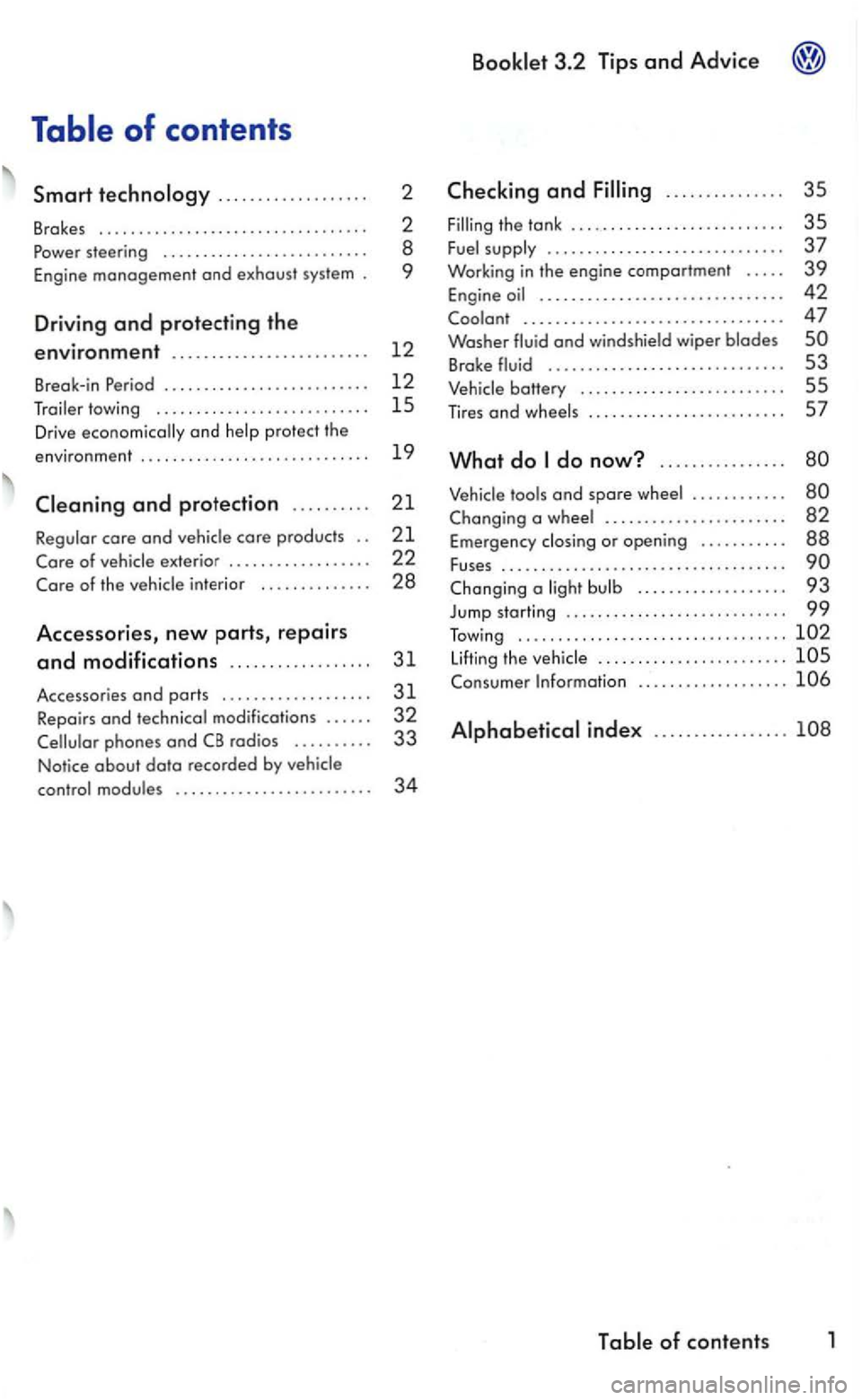
. . .. . . . . . . . . . . . .. . . 2
Brak es . .. . . .. .. .. . .. .. .. . .. .. .. . .. .. ... . 2 steering . . . . . . . . . . . . . . . . . . . . . . . . . . 8
Eng ine
management and exhaust sys tem . 9
Driving and protecting the
environment .. . .. .. .. .. .. .. .. . . . .. .. . 12
Break-in Period .. . .. .. .. .. .. .. .. .. .. .. .. . 12
towing .. .. . .. .. .. .. . .. . . .. . . .. .. . 15
Driv e economically and
core and
exterio r . . . . . . . . . . . . . . . .. . 22
Core of the in terior . . . . . . . . . . . . . . 28
Acce ssories, new parts, repairs
and modifications .. .. .. .. .. .. .. .. .. 31
Accessories and ports . . . . . . . . . . . . . . . . . . . 31
Repair s ond technical modifications . . . . . . 32
phones and
modules . . . . .. .. . . . . . . . . . . . . . . .. . 34
Checkin g and .. .. .. .. .. .. .. . 35
supply .. .. .. .. .. .. .. . .. .. .. .. .. . .. .. 37 Working in the engine comportment . . . . . 39
Engine .. .. .. .. .. .. .. .. .. .. . .. . .. .. .. . 42
................................. 47
Washer and windsh ield wiper blades
Broke . . . . . . . . . . . . . . . . . . . . . . . . . . . . . . 53
and spore . . . . . . . . . . . .. . .. . . .. .. .. .. . .. . .. .. 82
Emergency or opening . . . . . . . . . . . 88
Fuses . . . . . . . . . . . . . . . . . . . . . . . . . . . . . . . . . . .
. . .. . .. .. .. .. .. .. .. 93
Jump starting .. . .. .. . .. .. . .. . .. .. .. . .. .. . 99 Towing .................................. ........................
index .................
Page 285 of 444
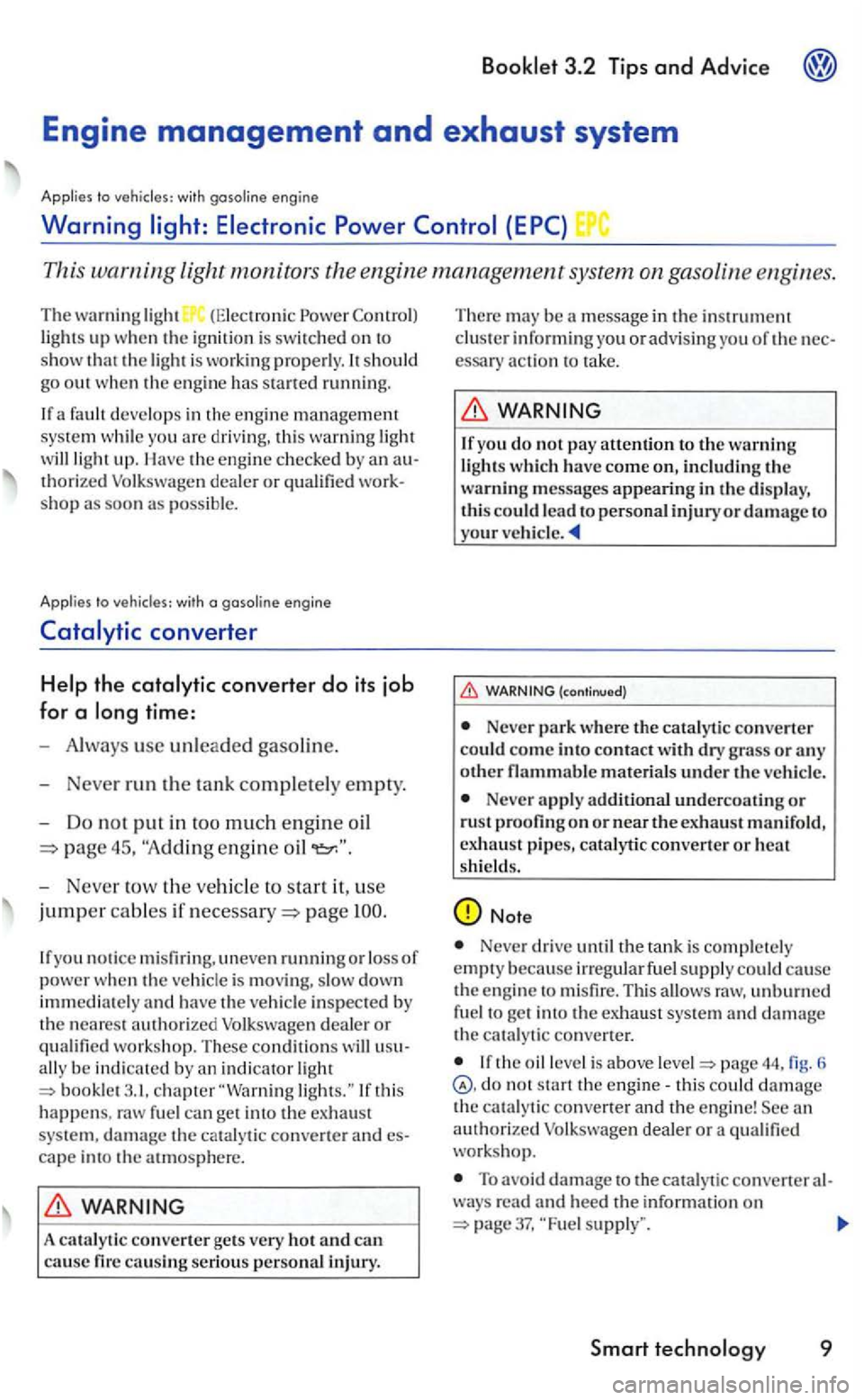
light monitors the
lights up when the ignit ion is sw itched on to
s how that the light is work ing properly. should
go ou t when the engin e ha s s tarted running.
a fault develops in the e ngin e management system while yo u are driving, thi s warning light
will light up. thorized dealer or qualified
the
t a nk completely empty.
- Do no t put in too much engine oil
45,
- Never tow the ve hicl e to sta rt use
jumper cables page
you notice misfiri ng, uneven running or loss of power whe n the vehicle is moving, slo w down
immedi at ely and have the ve hicle inspecte d b y the neares t authorized
chapter"Warning
cape int o the atmosphere.
A catalytic convert er ge ts very h ot and can
cause fir e causin g serious person al injury. Th
ere
may be a message in the in strument cluster inform ing you or advising you of th e essary ac tion to take.
yo u do not pay attention to the warning
li ghts which have come on, including th e warning messages appearing in th e d isplay, this could lead t o personal injury or damage to your vehic le.
(cont inued)
Never park whe re
Neve r apply additional undercoating or rust proofing o n or near the exhaust manifo ld,
ex hau st pipes, catalytic converter or heat s hi elds.
Note
Never drive until the tank is completely
e mpty becau se irregular fu el supply could cause the engine t o misfire. This allow s raw, unburned fu el to get into the ex haust sys tem and damage the catalytic conve rter.
the oil leve l is above page 44, fig. 6 not start the engine- t his could damage the catalytic co nverte r and the engine!
To avoid damage to the catalytic converter
37,
Page 316 of 444
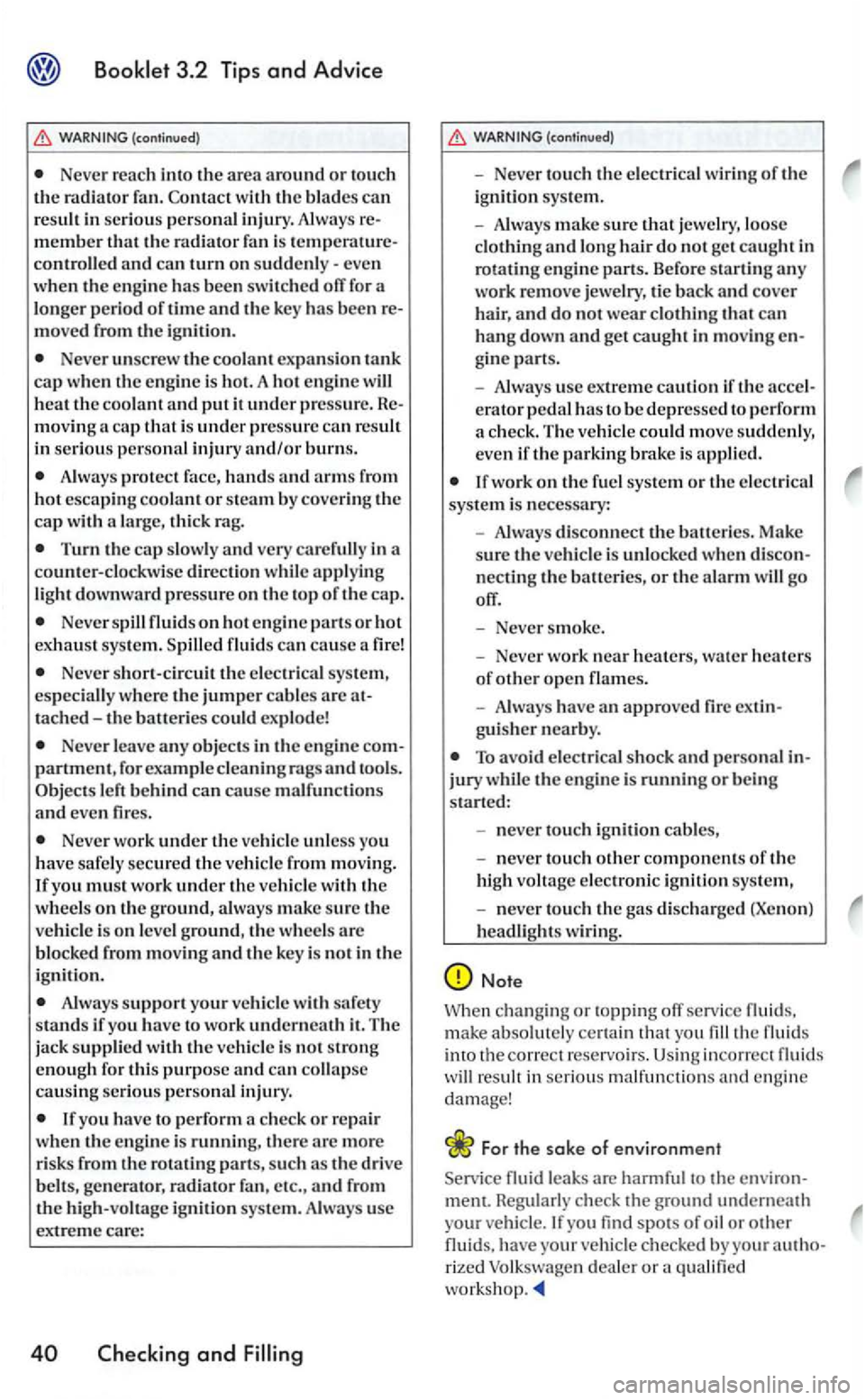
WARNING (continued)
Never reach into the area around or tou ch the radiator fan. Contact w ith the blade s can resuh in se riou s personal injury. Always m ember that the radiator fan is controll ed and can turn on
m oved from the ignit ion.
Never unscrew the coolant expa nsio n tank cap when th e engin e is hot. A hot engine will heat the coo la nt and put it under pressure . mov in g a cap that i s under pressure ca n rcsuh in seriou s personal injury and/or burns.
A lway s prote ct face, hand s and arms from hot esca ping coolant or steam b y cove ring the ca p with a large, thick rag.
Turn the cap slow ly a nd very carefully in a
counter- clo ckw ise direction whil e applying
light downward pressure on the top of the cap.
Never spill on hot engine parts o r hot
e xhau st sys te m . S pilled
Neve r short-circuitthc elec trica l sys te m ,
es peciall y w here th e jumper cabl es are tached -th e balleri es could explode!
Neve r leave any objects in the e ngine partment, for exam ple cleaning rag s and too ls. Objects
Neve r work unde r the veh ic le unless you
h ave safely secured th e ve hicl e from movin g.
I f yo u must work under th e ve hicl e wit h th e
w hee ls on th e ground, always make sure the vehicl e is on leve l ground, th e wh eels arc
b locked from movin g and th e key is not in the
ignition.
Always support your ve hicle with safety
s tands if you have to wo rk underneath it. The
ja ck suppli ed with the ve hicle is not s tron g enough for this purpose and can co llap se causin g se riou s personal injury.
If you have to perform a check or r ep a ir
w hen th e e ngine is running, there arc more
ri sks from
the ro tating parts, such as the drive
WARNING (con tinued)
Neve r to uch the e lec tr ica l w ir in g of the ig ni tio n sys tem.
Always make sure that j ewe lry, loose clothing and lo ng hair do not get caught in
rota ting engine pans. Before startin g any work remove jewelry, tie back and cover
hair, and do not wear clothing that can hang down and get caught in mov ing gin e parts.
Always use extre me cauti on if the erator pedal has to be depresse d to perform
a ch eck. The vehicle could move suddenly, eve n if the parking brake is applied.
If wor k on the fu el sys te m or th e electrica l
syste m is necessa ry:
Always discon nect th e balleries. Make
sure th e vehicle is unlo cked when
Neve r sm oke .
Neve r work nea r heaters, wa te r h eaters of other open names .
A lways have an approve d fire ext guis her nearby.
To avo id electrical shock and personal jury w hil e the eng ine is running or being
s tarted :
n ever touch ignition cables,
never to uch othe r component s of the
high vohage electronic ignition syste m,
never touch the gas discharged (Xeno n) headlights wiring.
Note
Whe n chang ing or topp ing orr service fluids. make absolutel y ce rtain that you fill the fluid s
into the corr ect reservoirs. Using incorrec t fluids will resuh in serious malf unct ions and engine
damage!
For the sake of environment
Service fluid leaks are harmful to the environ-
ment. Reg ularl y check the ground undernea th
your vehicle . you find spots of oil or other
fluids. have your vehic le checked by your rized dealer or a qualified
Page 375 of 444
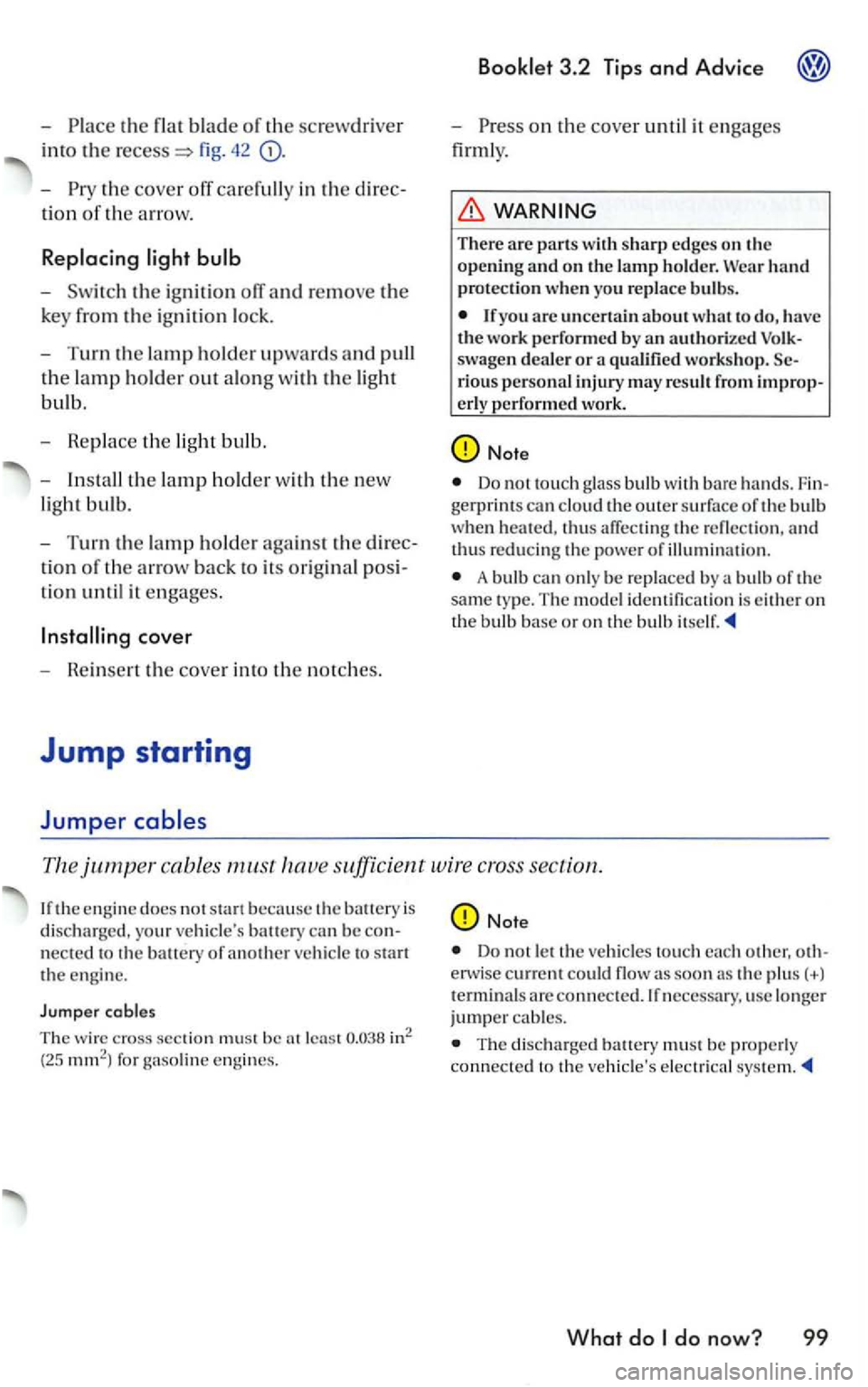
-Place the flat blade of th e screwdri ver
into the fig. 42
the cover off care full y in the dir ec
tio n of the a rrow.
Replacing
th e ig nit ion off and remove th e
key fr
om the ig nitio n lock.
- T
urn the lamp holder upwards and pull
the lamp holder out alo ng w ith the lig ht
bulb.
- Rep l
ace th e light bulb.
- Install
the lamp h o lder w ith the new
light bulb.
-
Turn t h e lamp hold er against the direc
tio n of th e a rrow back to its o rigina l posi
tion until it e n gages.
Booklet 3.2 Tips and Advice
-Press on the cove r until it engages
firmly.
There are parts with sharp ed ges on the opening and on the lamp holder. h and protection when yo u replace bulbs .
authorized Volk
s w age n dealer or a qu alifi ed workshop. rious person al injury may
Do not touch glass bulb with hands. Fingerprints can cloud the outer s u rface of the bulb
w hen heated. thus affect ing th e reflection, th us reducing the power of illumin at io n .
A bulb can o nly be rep laced by a bulb of the sam e type. The model identificat io n i s ei ther on the bulb base or on the bulb
cables must h ave sufficient wire cross section.
the engine does not is
disch arged, your vehicle's can be connected the batt ery of another vehicle to start the engine.
Jumpe r cables
T he wi re cross section mu st be in2
(25 1111112
) fo r g asoli ne e ngines.
Do no t let the ve hicles each other, o therwise current could flow as soon as th e plus(+) terminals areconnected.lf necessary.use longer jumpe r cables.
T he discharged battery must be p roperly connected to th e ve hicle's
What do
Page 376 of 444
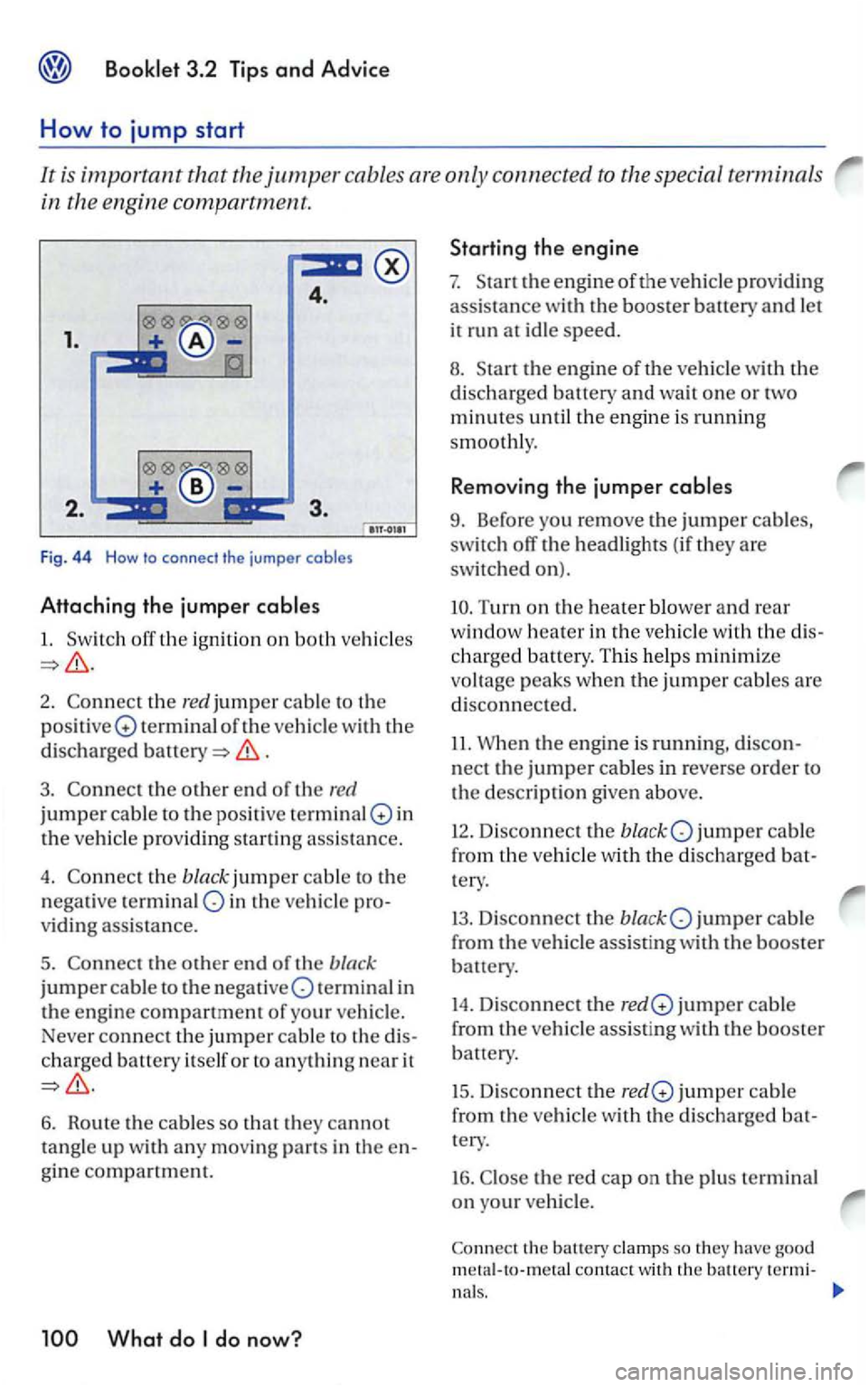
4.
1.
F ig. 44 How to connect the jumper cables
Attaching the jumper
1.
2. the red jumper cable to the
positi ve Q terminal of the vehicle with the
disch arg ed
.
3 . the other end of th e red
jumpe r cable to the posit ive terminal in
the veh icle providing startin g ass is ta n ce.
4. the black jumper ca ble to the
negative terminal in the vehic le
v idin g assistance.
5.
ch arged battery itself or to anything near it
6. Route the cables so that they cannot
tangle up with an y mo vin g parts in the
the engine of the vehicle with the
discharged battery and wait one or two
minutes until the engin e is running
s m
oothly.
Removing the jumper
9. Before you remove th e jumper cables,
switch off the headlights (if they are
switched on).
Turn on the heater blower and rear
window heater in the vehicl e with the
charged battery. This helps minimi ze
voltage peaks wh
en the jumper cables are
di sconnected.
11. Whe n the engine is running,
nect the jumper cables in r everse order to
the description given above.
12. Disconnect the jumper cable
fro m the vehicle with the di
scharged
jumper cable
from
the ve hicle assist ing with the booster
battery.
14. Disconn ect the jumper cabl e
from
the ve hicle assisting w ith the booste r
battery.
15. D isconnect the jumper ca ble
from the
vehicle with the discharged
th e re d cap on th e plu s te rminal
on your vehicle .
contact with the battery
Page 377 of 444
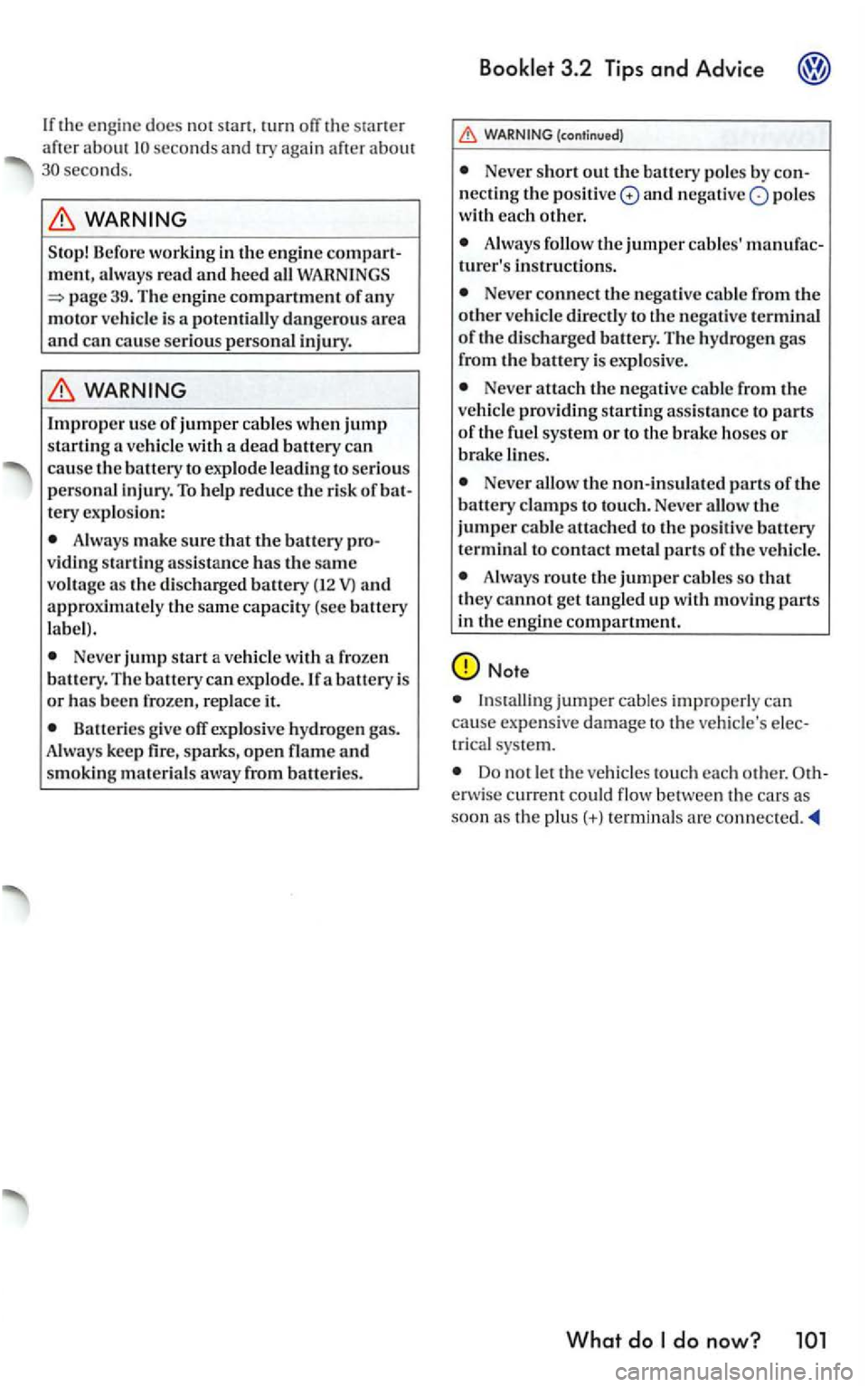
If th e e ng ine docs not stan, rum off the aft er ab o ut se cond s a nd try again about seconds.
39. The engine compartment of an y
motor vehicle is a potentiall y dangerous area and can cause seriou s personal injury.
tery explos ion:
Always make sure that the battery viding starting ass istance has the same voltag e as the di scharged battery (12 V) and
appr oximate ly the same capacity (see battery
lab el).
Never jump start a ve hicl e wit h a fro zen
battery. The battery can explode. If a battery i s or h as been frozen, re place it.
Batteries give off exp losive hydrogen gas.
Always keep sparks, open flame and
s moking mate rial s away from batteries.
(continued)
Never short out the battery poles by necting the positive and negative pole s
with each other.
Always follow the jumper cables '
Never connect the negativ e cable from the other vehicle directly to the negativ e terminal of th e di sc harged battery. The hydrogen from the battery is exp los ive.
Never attach the negativ e cabl e from the ve hicl e provid.ing starting assis tanc e to parts of the fuel system or to the brake hoses or brake lines.
Never the non-in sulated parts ofthe battery clamps to touc h. Never allow the jumper cable attached to the positive battery
terminal to contact metal parts of the vehicle.
Always rout e the jumper cables so that
they cannot tangled up w ith moving parts in the engin e compartment.
Note
Install ing jumper cables imp roper ly can
ca use expe nsive damage to the vehicl e's trical system.
Do not let the vehicle s tou ch each othe r. e rwise current could flo w between th e cars as soon as the plus(+) te rminal s arc
What do
Page 380 of 444
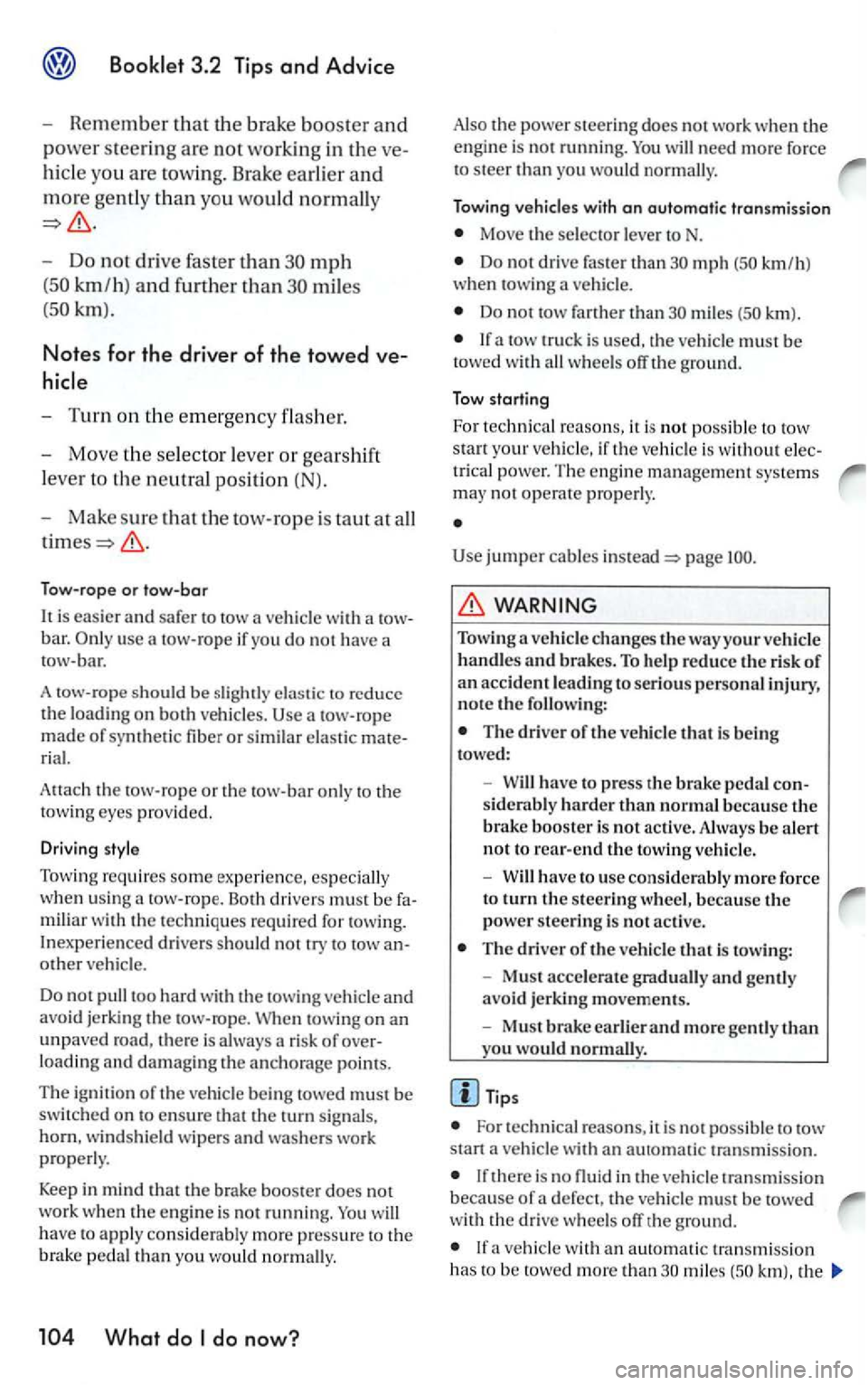
hicle yo u are tow ing. Brake earlier and
more gently than you wou ld normally
- Do not drive faster than mph
miles
-Turn on the emergency flasher.
-Move the se lecto r lever or gearshift
l eve r to
the neutral position (N).
- Make s
ure that the tow-rope is taut at all
Tow-rope or lo w-bar
bar. use a tow -rope if you do not have a
tow -bar.
A tow-ro pe s ho uld
be slightl y elastic to reduce the loading on both ve hicl es. Use a tow -rope made of synthetic fiber or similar ela stic
load ing and damaging the anchorage points.
T he ignition
of the vehicle bein g to we d must be switched on to ensure
will
hav e to apply considera bly more press ure to the brak e pedal than you would normally.
Move the selec tor leve r toN.
Do not drive fas te r than mph
Do not tow farth er than mil es km).
a tow truck is used, the vehicl e must be tow ed with all wheels the ground.
Tow starti ng
For technica l rea sons,
it is not pos sibl e to tow start you r vehicle, if the vehicl e is without trical power. The engine management systems may not operate prop erly.
Use jumper cables page
WARNING
Towing a ve hicle changes th e way your ve hicle
h an dles and brakes. To help reduce the risk of
a n accident lea ding to serio us personal i njury, note the fo ll owi ng:
T he drive r of the vehi cle t hat is being towed:
Will have to press the brake pedal
Will have to use considerably more force
to turn t h e s teering wheel, because th e
power s teerin g is no t ac tive.
The driver of the vehicle that is towing:
Must accelerate gradually and gently avoid jerking movements.
Mus t brake earlie r and more ge ntl y than you would normally.
Tips
For technical r easo ns, it is not possible to sta rt a ve hicle with an aut omati c transmission.
th ere is no fluid in the vehicle transmission because o f a defect. th e vehicle must be tow ed
w ith the dri ve whee ls t h e ground.
a veh icle with an automati c tra nsmission has to be towed more th an miles